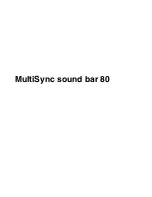
CBT36K Assembly Manual
14.1.12.
CBT36 Specifications in Brief:
14.1.12.1. Description:
The CBT36 is a ground-plane CBT two-way floor-standing 36° circular-arc high-end loudspeaker line array. Each
system contains 18 each 3-1/2” full-range drivers used as mid-woofers and 72 each ¾” diameter wide-band tweeters
with a 0.5” inverted aluminum dome.
The system is broad-band constant directivity and beamwidth from 200 Hz and up and supplies an extremely-even
coverage and frequency response to all parts of the listening room. The system has exceptionally well-behaved and
smooth coverage from locations well above the array to points even down at floor level, and at distances from directly
in front of the speaker to points in the rear of the listening room. The horizontal coverage is extremely broad, but well
controlled and uniform even out to plus-minus 90 degrees.
The CBT36's variation of loudness with distance is also very unique. At standing height, the system's volume level
hardly changes over a range from directly in front of the system to points 12 feet away!
In addition to providing very-even and flat coverage at all the locations listed above, the CBT36 is also linear phase
and time-aligned at all the same positions! (Hey, I can hear all you doubters out there already. How can it be time
aligned with all those signals coming from all those drivers? Just take it from me (Keele), it is and this can be traced
back to the original CBT work done by the US Navy. I will soon be authoring an AES paper on the time and phase
behavior of CBT arrays which will reinforce the points.)
14.1.12.2. Frequency Response:
60 Hz to 20 kHz, ±2.5 dB, measured at any point over a non-carpeted floor in front of the system. With carpet, the
response is equally flat but measured at points above about one foot above the floor. At lower points below one foot
the high-frequency response is somewhat rolled off.
14.1.12.3. Phase and Time Response:
Linear phase and time aligned at most locations in front of and to the sides of the array.
14.1.12.4. Sensitivity (2.83 Vrms/1m):
Note: the raw sensitivity (no crossover or EQ) of the CBT36 is frequency dependent. It is roughly flat from 80 to 300
Hz and then rolls off at 3 dB/octave (10 dB/decade) up to 20 kHz. See later section “CBT36 Power Rolloff” in
Appendix 2 for further explanation of this rolloff. For more details see Fig. 26 in this section. Here are some
approximate sensitivity numbers at different frequencies:
80 to 300 Hz:
94 dB
800 Hz:
89 dB
8 kHz:
79 dB
14.1.12.5. Crossover:
Bi-amped at 1 kHz with 4
th
-order Linkwitz–Riley filters, 24 dB/octave slopes. This very-low crossover frequency
insures that the horizontal coverage is well behaved and lobe free out to ±90°.
14.1.12.6. Shading Bank attenuation (ranging from the bottom to the top of the array):
Bank 1: 0 dB (6 mid-bass, 24 tweeters), Bank 2: -2.5 dB (4 mid-bass, 16 tweeters), Bank 3: -4.5 dB (4 mid-bass, 16
tweeters), Bank 4: -8.0 dB (2 mid-bass, 8 tweeters), Bank 5: -11.0 dB (2 mid-bass, 8 tweeters).
The loudspeakers of the CBT36 are not equally driven but are passively “shaded” in five banks that attenuate the
upper drivers with respect to the lower drivers. The drivers at the bottom of the system are on full, while the higher
drivers are attenuated progressively as they get closer to the top of the array. The curved circular-arc shape of the
CBT36 front panel and the shading vastly improves the vertical coverage and coverage consistency with frequency
as compared to a straight-line equally-driven array.
14.1.12.7. Coverage:
Horizontal: a controlled ±90°, Vertical: a very-well controlled 27° above-ground beamwidth from 250 Hz on up. The
restricted vertical beamwidth greatly reduces energy directed up to the ceiling.
14.1.12.8. Nominal Impedance:
4 Ohms (Not falling below 3.9 Ohms for LF and 3.6 Ohms for HF, see following section for graphs).
14.1.12.9. Amplifier Requirements:
LF: 50 to 500 Watts. HF: 50 to 150 Watts. Higher powered amps can be used to reproduce short-term transients
without clipping for high crest-factor program material.
14.1.12.10. Maximum Input Voltage and Power:
The long-term continuous power rating of the CBT36 is limited primarily by the power rating of the shading network
resistors. These resistors were chosen for typical domestic listening situations with power amplifiers of no more than
200 Watts (into four Ohms) playing program material with crest factors (peak to average power ratio) no lower than
10 dB. This means that if you turn the system up to the point where typical program material just starts to clip, using a
typical 200 W four-ohm rated power amplifier, and then listen at this loudness (loud!) for long periods, the system’s
shading resistors will not overheat. For “pro-sound” applications of the CBT36 with the CBT36s being driven hard by
larger amplifiers, we recommend increasing the power of each shading resistor from 12 Watts to about 50 Watts.
Short Term (One minute or less):
LF: 45 Vrms (500 Watts in 4 Ohms). HF: 21 Vrms (110 Watts in 4 ohms).
Long Term (Continuous):
LF: 20 Vrms (100 Watts in 4 Ohms). HF: 15 Vrms (150 Watts in 4 ohms).
Page
76
of 89














































